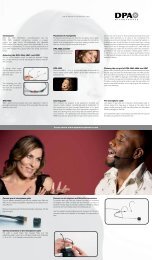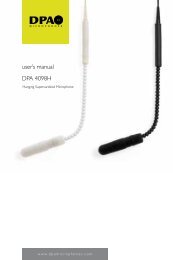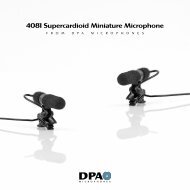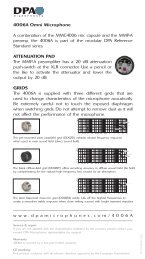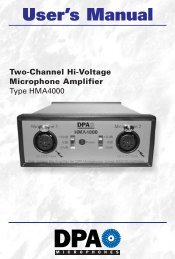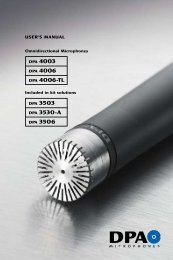The essentials of microphone technology â how ... - DPA Microphones
The essentials of microphone technology â how ... - DPA Microphones
The essentials of microphone technology â how ... - DPA Microphones
Create successful ePaper yourself
Turn your PDF publications into a flip-book with our unique Google optimized e-Paper software.
w w w . d p a m i c r o p h o n e s . c o m / m i c u n i<br />
<strong>The</strong><br />
How to choose<br />
<strong>essentials</strong><br />
the right mic for the job<br />
<strong>of</strong> <strong>microphone</strong> <strong>technology</strong><br />
<strong>The</strong> <strong>essentials</strong> <strong>of</strong> <strong>microphone</strong> <strong>technology</strong>: How to choose the right mic for the job
W W W . D P A M I C R O P H O N E S . C O M<br />
Contents<br />
1. Getting the right <strong>microphone</strong><br />
2. Live vs. studio miking<br />
3. Dynamic vs. condenser <strong>microphone</strong>s<br />
4. Testing your <strong>microphone</strong><br />
5. Directional/cardioid vs. omnidirectional <strong>microphone</strong>s<br />
6. Large vs. small diaphragms<br />
7. How to read <strong>microphone</strong> specifications<br />
<strong>The</strong> <strong>essentials</strong> <strong>of</strong> <strong>microphone</strong> <strong>technology</strong>: How to choose the right mic for the job
Getting the right<br />
<strong>microphone</strong><br />
Before buying a <strong>microphone</strong>, it is essential to make sure<br />
that it will do the job you want it to do. This means that<br />
you have to clearly understand which application(s) the<br />
<strong>microphone</strong> was designed for.<br />
<strong>The</strong>re is no such thing as an all-purpose <strong>microphone</strong><br />
that is ideal for every application. Differences in pickup<br />
pattern, maximum SPL constraints and noise floor<br />
should all be taken into account during the selection<br />
process. All <strong>microphone</strong>s are made for a certain purpose<br />
or sometimes a compromise between several related<br />
purposes.<br />
Is it primarily for recording in a studio or home studio,<br />
is it for live use or perhaps both? Is it meant for one<br />
specific instrument or sound source or should it be for<br />
more general use? Is it to be mounted on a stand, an<br />
instrument, a head or is it handheld?<br />
Is your budget limited? Quality always costs. You can<br />
save money on features you don’t need, but to most<br />
people quality is a feature they do need.<br />
<strong>The</strong> main problem with a live setting is the large number<br />
<strong>of</strong> other loud sound sources other than the one you<br />
wish to amplify or record such as the P.A. front and the<br />
monitors that can cause feedback, or the other musicians<br />
and their amps that are <strong>of</strong>ten much louder than the<br />
voice or s<strong>of</strong>ter instrument you need to mic.<br />
This means that the primary objective for a live <strong>microphone</strong><br />
is separation and secondarily good <strong>of</strong>f-axis sound<br />
(sound taken in from the side/back <strong>of</strong> the <strong>microphone</strong>s).<br />
If the monitor and amplifier level on stage is controlled<br />
and relatively low, it is possible to gain more clarity and<br />
definition by using less directional <strong>microphone</strong>s.<br />
Dynamic vs.<br />
condenser mics<br />
Dynamic <strong>microphone</strong>s are, in brief terms, a reverse dynamic<br />
loudspeaker (you can actually use a loudspeaker<br />
as a dynamic mic – don’t try the opposite). It’s a moving<br />
coil in a permanent magnet. <strong>The</strong> diaphragm is attached<br />
to the coil, and when it moves, it produces varying current<br />
through electromagnetic induction.<br />
<strong>The</strong> construction <strong>of</strong> dynamic mics is quite simple, which<br />
makes them rugged and inexpensive and they don’t<br />
require external power. <strong>The</strong> rugged heavy construction<br />
also makes them more ‘forgiving’ with less resolution.<br />
Most common applications are live – especially on vocals,<br />
drums and amplifiers.<br />
A condenser <strong>microphone</strong> consists <strong>of</strong> a capacitor, where<br />
one side is the diaphragm and the other is the back<br />
plate which is polarized either from an external power<br />
source or by prepolarization. As the diaphragm moves<br />
it changes the capacitance, and these changes are then<br />
amplified to make a transmittable signal.<br />
Live vs. studio<br />
miking<br />
<strong>The</strong> main difference between these two environments is<br />
not the sound source itself but the surroundings.<br />
All condenser mics need external power (referred to as<br />
phantom power) to energize the internal electronics.<br />
<strong>The</strong>y produce a sound signal <strong>of</strong> a much higher quality<br />
than the dynamic mics, but they are more expensive,<br />
and a little more fragile to use, <strong>how</strong>ever newer <strong>technology</strong><br />
has made them far more resistant to rough use,<br />
and the use <strong>of</strong> condensers in live applications is on the<br />
rise.<br />
<strong>The</strong> studio is a relatively controlled environment, where<br />
you <strong>of</strong>ten are given a second chance if the result is not<br />
satisfactory. For that reason your expectations <strong>of</strong> the result<br />
will, <strong>of</strong> course, also be much higher. That means the desire<br />
for clarity, definition and low noise has no upper limit.<br />
In order to compensate for poor sounding acoustics or<br />
to get more channel separation when multiple instruments<br />
are recorded, directionality can be more important<br />
than definition and noise.<br />
<strong>The</strong> <strong>essentials</strong> <strong>of</strong> <strong>microphone</strong> <strong>technology</strong>: How to choose the right mic for the job
Testing your<br />
<strong>microphone</strong><br />
For live use you generally want as much suppression<br />
<strong>of</strong> <strong>of</strong>f-axis sound as possible. You only wish to hear<br />
the sound source itself. But very hard suppression <strong>of</strong>ten<br />
gives a very uneven <strong>of</strong>f-axis sound that will give the<br />
impression <strong>of</strong> ‘unnatural’ sound reproduction.<br />
Usually this compromise relates to the genre <strong>of</strong> music<br />
you play. An acoustic low volume genre really appreciates<br />
an open, natural and clean sound, whereas the<br />
louder the volume and the higher the need for gain<br />
before feedback, the higher tolerance towards ‘unnatural’,<br />
amplified sound.<br />
Never test a <strong>microphone</strong> alone. It’s always easier to hear<br />
a <strong>microphone</strong>’s character if you compare it to something.<br />
It is important to keep in mind that the acoustic memory<br />
<strong>of</strong> the human being is only a few seconds. You can’t<br />
rely on your memory <strong>of</strong> a <strong>microphone</strong> you tried last<br />
week, you need to be able to switch back and forth<br />
– A/B-testing. You can either test against an alternative<br />
<strong>microphone</strong> you are considering buying or one <strong>of</strong> your<br />
own <strong>microphone</strong>s that you are very familiar with.<br />
Compare their on-axis sound. For a studio <strong>microphone</strong><br />
this can be done at two different distances: 30 cm,<br />
which is the normal distance when recording a vocal,<br />
and for further testing, 3 cm on a loud sound source<br />
to check its upper dynamic range. If it’s a directional<br />
<strong>microphone</strong>, this will also help to check proximity effect<br />
and pop noise (more about this later).<br />
For all <strong>microphone</strong> testing using a really challenging<br />
sound source can be very revealing. Try testing with a<br />
large ring <strong>of</strong> keys. <strong>The</strong> sound <strong>of</strong> jangling keys has some<br />
very complex high frequencies that are difficult to reproduce.<br />
Good mics can, but lesser mics sound like you are<br />
crumbling a piece <strong>of</strong> paper.<br />
To test a live <strong>microphone</strong> you wish to hear its performance<br />
in its normal environment, so standing in front<br />
<strong>of</strong> a P.A. facing the stage would be ideal. Place the <strong>microphone</strong><br />
as it will normally be used, usually very close<br />
to the sound source, and again always test multiple mics<br />
at the same time.<br />
In live use gain before feedback is very important. You<br />
therefore need to test at quite high volumes to see<br />
which <strong>microphone</strong> feeds back first.<br />
Next compare their <strong>of</strong>f-axis sound. On directional <strong>microphone</strong>s<br />
you need to check the suppression <strong>of</strong> <strong>of</strong>f-axis<br />
sound. How hard is the suppression and – also very<br />
important – <strong>how</strong> good it sounds.<br />
-<br />
-<br />
Directional/cardioid<br />
vs. omnidirectional<br />
<strong>microphone</strong>s<br />
<strong>Microphones</strong> can have different directional characteristics.<br />
Omnidirectionals that pick up the sound all around<br />
them, and cardioids that mainly pick up the sound<br />
directly in front <strong>of</strong> them. Other directional patterns are:<br />
bidirectional/figure 8, supercardioid, hypercardioid, and<br />
wide cardioid.<br />
Generally a cardioid sounds appealing, since in a musical<br />
setting you only want the sound source and rarely<br />
want to record or amplify the surroundings. But directionality<br />
has a price and that sometimes is not worth<br />
paying.<br />
Directional <strong>microphone</strong>s need to have a much s<strong>of</strong>ter diaphragm<br />
than an omni. This s<strong>of</strong>tness results in handling,<br />
pop and wind noise which puts a limit to <strong>how</strong> close<br />
you can get to a vocalist, even when using pop-filters.<br />
A directional mic also suffers from proximity effect, which<br />
means that the closer you get to the sound source the<br />
louder the low frequencies get and vice versa.<br />
<strong>The</strong> proximity effect exhibited by the <strong>DPA</strong> 4011-TL<br />
Cardioid Microphone.<br />
<strong>The</strong> <strong>essentials</strong> <strong>of</strong> <strong>microphone</strong> <strong>technology</strong>: How to choose the right mic for the job
A cardioid <strong>microphone</strong> can be adjusted to be linear at<br />
the distance it is normally used. A vocal <strong>microphone</strong> for<br />
live use, for example, is adjusted to be linear at a distance<br />
<strong>of</strong> approximately 1 – 2 cm and at longer distances the<br />
low frequencies drop dramatically. A studio <strong>microphone</strong> is<br />
typically adjusted to work at a longer distance.<br />
In the example <strong>of</strong> the <strong>DPA</strong> 401-TL, when used closer<br />
than 30 cm it gives a low frequency boost, and when<br />
used further than 30 cm it gives a low frequency roll<strong>of</strong>f.<br />
That means that from any other distance than 30<br />
cm equalization is needed unless the proximity effect is<br />
desired.<br />
Additionally the <strong>of</strong>f-axis sound <strong>of</strong> a cardioid is less linear<br />
than that <strong>of</strong> an omni. It is very hard to reduce the level<br />
<strong>of</strong> sound taken in from the sides without some coloration,<br />
and some directional <strong>microphone</strong>s have a notably<br />
poor <strong>of</strong>f-axis response.<br />
This means that sound entering the <strong>microphone</strong> from<br />
the sides and the rear are more or less strongly colored<br />
– the industry names this “the curtain effect”. This<br />
effect can be seen on the <strong>microphone</strong>s polar pattern<br />
as ‘spikes’.<br />
On the other hand, miking live with high level monitors<br />
can make the omni mic feed back, which makes the<br />
cardioids more suitable for this application, although the<br />
use <strong>of</strong> in-ear monitors reduces that problem.<br />
Source<br />
Omnidirectional<br />
Cardioid<br />
Bidirectional<br />
Relative distance to sound source for equal balance<br />
between direct and indirect sound.<br />
Multi-pattern <strong>microphone</strong>s with both omnidirectional,<br />
bidirectional and cardioid characteristics will always compromise<br />
the sound quality. It may be very convenient<br />
to have a 3-in-1 solution, but the drawback is reduced<br />
performance in each mode.<br />
Due to the need <strong>of</strong> a pressure gradient design, a multipattern<br />
<strong>microphone</strong> in omni mode has many <strong>of</strong> the<br />
weaknesses <strong>of</strong> the cardioid, such as popping, handling<br />
and wind noise and a less linear <strong>of</strong>f-axis sound. In fact<br />
a multi-pattern <strong>microphone</strong> in the same mode can have<br />
different characteristics depending on the frequency.<br />
Large vs.<br />
small diaphragms<br />
1 1.7 1.9 2<br />
Supercardioid<br />
Hypercardioid<br />
Before choosing between a large and a small diaphragm<br />
<strong>microphone</strong> it is important to know the difference in<br />
features between them, and <strong>microphone</strong> behavior can<br />
not be compared with that <strong>of</strong> a loudspeaker when<br />
considering size.<br />
If you choose an omnidirectional <strong>microphone</strong>, channel<br />
separation may be less precise than with a directional<br />
<strong>microphone</strong>, because the omni will pick up sound from<br />
all directions. <strong>The</strong>refore, if channel separation is preferred,<br />
the ratio between direct and indirect sound can become<br />
more unfavorable with an omni.<br />
<strong>The</strong> omni, <strong>how</strong>ever, can be moved closer to the source,<br />
without the penalty <strong>of</strong> proximity effect. As a general rule<br />
it can be said that if we place a cardioid at a distance<br />
<strong>of</strong> 17 cm to the source, then an omni placed at 10 cm<br />
gives the same ratio <strong>of</strong> direct and indirect sound as the<br />
cardioid.<br />
A large diaphragm <strong>microphone</strong> is not better at reproducing<br />
low-frequencies, but it may be less precise in<br />
reproducing high frequencies, which may make it sound<br />
as if it has more low end.<br />
A small diaphragm has a higher self noise due to the fact<br />
that the small diaphragm is less compliant and therefore<br />
more sensitive to the bombardment <strong>of</strong> air molecules<br />
that causes some <strong>of</strong> the self noise <strong>of</strong> a <strong>microphone</strong>. And<br />
since the large diaphragm is s<strong>of</strong>ter than the small, it is<br />
easier to move and therefore more sensitive – even at<br />
very low levels.<br />
This means that the small diaphragm, because it’s stiff,<br />
can handle a higher sound pressure without clipping or<br />
distortion, but is less sensitive and needs more amplification,<br />
which also adds a little noise.<br />
<strong>The</strong> <strong>essentials</strong> <strong>of</strong> <strong>microphone</strong> <strong>technology</strong>: How to choose the right mic for the job
When reproducing very high frequencies, large diaphragm<br />
<strong>microphone</strong>s have a more limited range than<br />
the small diaphragms. This is caused by three factors:<br />
1. A large diaphragm tends to break up and will no<br />
longer act as a true piston. This phenomenon is also<br />
recognized in loudspeaker <strong>technology</strong> and is the reason<br />
why loudspeakers are manufactured with different sizes<br />
<strong>of</strong> diaphragms to handle different frequencies.<br />
2. <strong>The</strong> weight <strong>of</strong> the diaphragm will attenuate the displacement<br />
<strong>of</strong> the diaphragm for higher frequencies.<br />
3. <strong>The</strong> diffractions around the edges <strong>of</strong> the <strong>microphone</strong><br />
capsule will limit the <strong>microphone</strong>’s capability to handle<br />
very high frequencies.<br />
Conclusion<br />
Both diaphragm sizes have their respective advantages<br />
and disadvantages. This is illustrated in this table, which<br />
compares the specifications <strong>of</strong> <strong>DPA</strong>’s small and large diaphragm<br />
<strong>microphone</strong>s:<br />
How to read<br />
mic specifications<br />
When you read <strong>microphone</strong> specifications in order to<br />
compare different <strong>microphone</strong>s, it is extremely important<br />
that you understand <strong>how</strong> to interpret them.<br />
In most cases the specifications can be measured or calculated<br />
in many different ways. This article is designed to<br />
help evaluate specifications in a meaningful way.<br />
While <strong>microphone</strong> specifications provide an indication<br />
<strong>of</strong> a <strong>microphone</strong>’s electro-acoustic performance, they will<br />
not give you the total appreciation <strong>of</strong> <strong>how</strong> it will sound<br />
– just as it is with cars. Knowing that it is a 3.0 turboengine<br />
with 4WD gives you an idea <strong>of</strong> a pretty good<br />
driving experience, but for the exact feeling, you need to<br />
drive the car yourself.<br />
Frequency range/frequency response<br />
Frequency range tells you the range <strong>of</strong> the frequencies<br />
(for example 20 Hz to 20 kHz) that the <strong>microphone</strong><br />
can pick up and reproduce, but not <strong>how</strong> well the different<br />
frequencies are reproduced. To see that you need<br />
the frequency response:<br />
10<br />
dB<br />
5<br />
0<br />
On-axis<br />
-5<br />
-10<br />
5 dB Diffuse<br />
-15<br />
10 20 Hz 50 100 200 Hz 500 1 kHz 2 5 10 20 40<br />
Both diaphragm sizes have their respective advantages<br />
and disadvantages. This is illustrated in the table above.<br />
Frequency response <strong>of</strong> <strong>DPA</strong> 4006 Omnidirectional Microphone,<br />
P48.<br />
Here you see <strong>how</strong> linear the response is or if the <strong>microphone</strong><br />
has any ‘spikes’. But pay attention to the scale<br />
on the left. <strong>The</strong> number <strong>of</strong> dB each step represents can<br />
vary a lot.<br />
<strong>The</strong> frequency response normally refers to the on-axis response,<br />
which means from a sound source right in front<br />
<strong>of</strong> the <strong>microphone</strong>. <strong>The</strong> diffuse field response curve will<br />
illustrate <strong>how</strong> the <strong>microphone</strong> will respond in a highly<br />
reverberant sound field.<br />
It is also important to examine the <strong>of</strong>f-axis response.<br />
A <strong>microphone</strong> always takes in sound from the sides too,<br />
the question is just <strong>how</strong> much and <strong>how</strong> good it sounds.<br />
In particular, directional <strong>microphone</strong>s can, in their attempt<br />
to suppress sound from the sides, get an uneven<br />
<strong>of</strong>f-axis response:<br />
<strong>The</strong> <strong>essentials</strong> <strong>of</strong> <strong>microphone</strong> <strong>technology</strong>: How to choose the right mic for the job
Sensitivity, sound pressure level (SPL) handling<br />
and total harmonic distortion (THD)<br />
Sensitivity tells you <strong>how</strong> well the <strong>microphone</strong> can convert<br />
the acoustic sound into electricity and according to the<br />
IEC 60268-4 norm, the sensitivity is measured in mV per<br />
Pascal (air pressure) at 1 kHz. <strong>The</strong> higher the sensitivity<br />
the better, because it reduces the need for amplification<br />
and therefore reduces the amplification noise.<br />
On- and <strong>of</strong>f-axis responses <strong>of</strong> <strong>DPA</strong> 4011-TL/4012/4021/<br />
4022/4023 cardioid <strong>microphone</strong>s measured at 30 cm.<br />
Finally a polar plot can s<strong>how</strong> the 360° response <strong>of</strong><br />
selected frequencies. <strong>The</strong> response curves should be<br />
smooth and symmetric to s<strong>how</strong> an uncolored sound.<br />
Extreme peaks and valleys are unwanted and the response<br />
curves should not cross each other.<br />
From the polar diagram you can also see <strong>how</strong> omnidirectional<br />
<strong>microphone</strong>s usually become more directional<br />
at higher frequencies.<br />
SPL handling tells you <strong>how</strong> much sound pressure in dB<br />
the <strong>microphone</strong> can handle before it either clips (the<br />
diaphragm hits the backplate or the amplifier overloads)<br />
or reaches a certain level <strong>of</strong> distortion (THD or total<br />
harmonic distortion). Typically either 0,.5 % or 1 %. <strong>The</strong><br />
higher level <strong>of</strong> sound pressure before clip or distortion<br />
the better.<br />
Example:<br />
<strong>DPA</strong> 4004 Hi-SPL Omnidirectional Microphone, 130 V:<br />
Maximum sound pressure level:168 dB SPL peak<br />
Total harmonic distortion:142 dB SPL peak (
w w w . d p a m i c r o p h o n e s . c o m / m i c u n i<br />
Microphone University<br />
Application Guide<br />
Microphone Guide<br />
<strong>DPA</strong>’s online Microphone<br />
University is your pro audio<br />
learning center, providing a<br />
wealth <strong>of</strong> articles discussing<br />
all things <strong>microphone</strong>.<br />
Subjects include basic technical<br />
information, <strong>microphone</strong><br />
placement, applications, stereo<br />
and surround recording.<br />
<strong>The</strong> Application Guide <strong>of</strong>fers<br />
useful tips about which <strong>microphone</strong>s<br />
to use and <strong>how</strong><br />
to use them on a variety <strong>of</strong><br />
instruments.<br />
From acoustic guitar and<br />
banjo to trumpet and violin,<br />
this guide shares tips on<br />
<strong>how</strong> to find your instrument’s<br />
sweet spot.<br />
Whether you are a recording<br />
musician, a Foley artist, or an<br />
audio engineer for a house<br />
<strong>of</strong> worship, the <strong>DPA</strong> Microphone<br />
Guide is a great place<br />
to start.<br />
<strong>The</strong>re is a <strong>DPA</strong> <strong>microphone</strong><br />
for every job – use the Mic<br />
Guide as a quick and easy<br />
way to find the right one.<br />
<strong>The</strong> <strong>essentials</strong> <strong>of</strong> <strong>microphone</strong> <strong>technology</strong>: How to choose the right mic for the job




